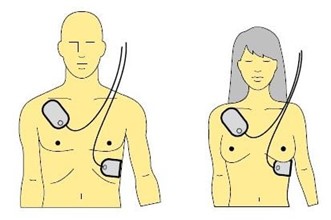AED electrodes on adult patients
Applying AED electrodes
An AED has two electrodes that you apply to the patient's chest. These electrodes are needed for heart rhythm analysis and for delivering the shock. Proper electrode placement ensures accurate analysis and effective shock delivery. Read more about sticking AED electrodes here.
Where should the AED electrodes be attached?
To properly apply AED electrodes, follow these steps:
- Attach the electrodes to the bare skin of the chest.
- Before attaching the electrodes, remove, loosen, or unbutton any outer clothing to expose the chest.
- Ensure the skin is dry using a towel, sleeve, or other garment to remove all moisture.
- Remove jewellery.
- Remove plasters.
- If the patient has a lot of chest hair, shave the chest so the electrodes stick better to the skin.
With most AEDs, you will find a small pouch with supplies such as gloves and a razor blade (rescue kit). Once the above points are in order, you can start sticking the electrodes. You stick them one by one.


Attaching the AED electrodes on adult patient
On an adult patient, you stick one electrode on the right side of the chest, between the collarbone and the nipple. You stick the other electrode on the left side of the chest, just below the breast, at the level of the ribs.
If you imaginatively draw a line between the electrodes, the heart is between them. Note: do not stick the electrodes on the collarbone or the nipple. In children, you sometimes stick the electrodes differently. For more information, see AED electrodes in children.
What to do if you forget how to place the AED electrodes?
If you forget how to place the AED electrodes, don't worry. The availability of mnemonics makes it possible for anyone to operate an AED. Additionally, every AED comes with instructions through spoken guidance or a visual display. Images demonstrating where to attach the electrodes are often on the electrodes and the packaging.
Experienced rescuers may not need to rely on the AED's instructions and can quickly apply the electrodes to speed up the analysis process. If performing CPR with another person, one person can continue chest compressions and ventilations while the other attaches the electrodes, allowing for a more efficient response.
Can the electrodes be reattached if they are not attached correctly?
In most cases, it is not advisable to reattach electrodes. Usually, the analysis can continue, and the defibrillation shock will administer even if the electrodes are not reattached perfectly. Attempting to reattach the electrodes would take up valuable time. It's also essential to consider the conductive gel on the electrodes. When removing the electrodes, some of the gel may remain on the patient's chest, resulting in insufficient gel on the electrodes for appropriate reattachment.
What do you do in a patient with a pacemaker?
You can also use an AED on patients with a pacemaker or ICD. Don't let the presence of a pacemaker/ICD slow you down. See if you can place the electrodes 8 cm next to the pacemaker/ICD. If it is not possible, attach the electrodes beside the pacemaker/ICD.
Can a victim also be defibrillated on a wet surface?
In a wet environment (e.g. in the pool, drowning on the beach, etc.), it is necessary to dry the victim's chest before attaching the electrodes. Take great care that the electrodes stick sufficiently to the victim's chest! In addition, no one (including yourself) must touch the victim while delivering the shock.